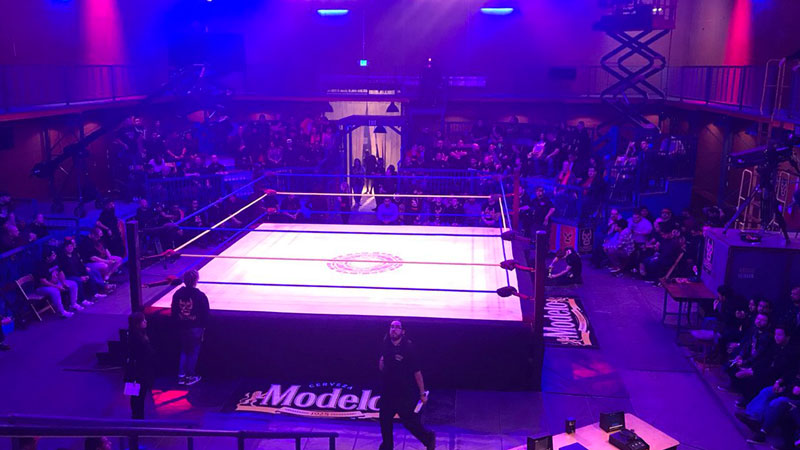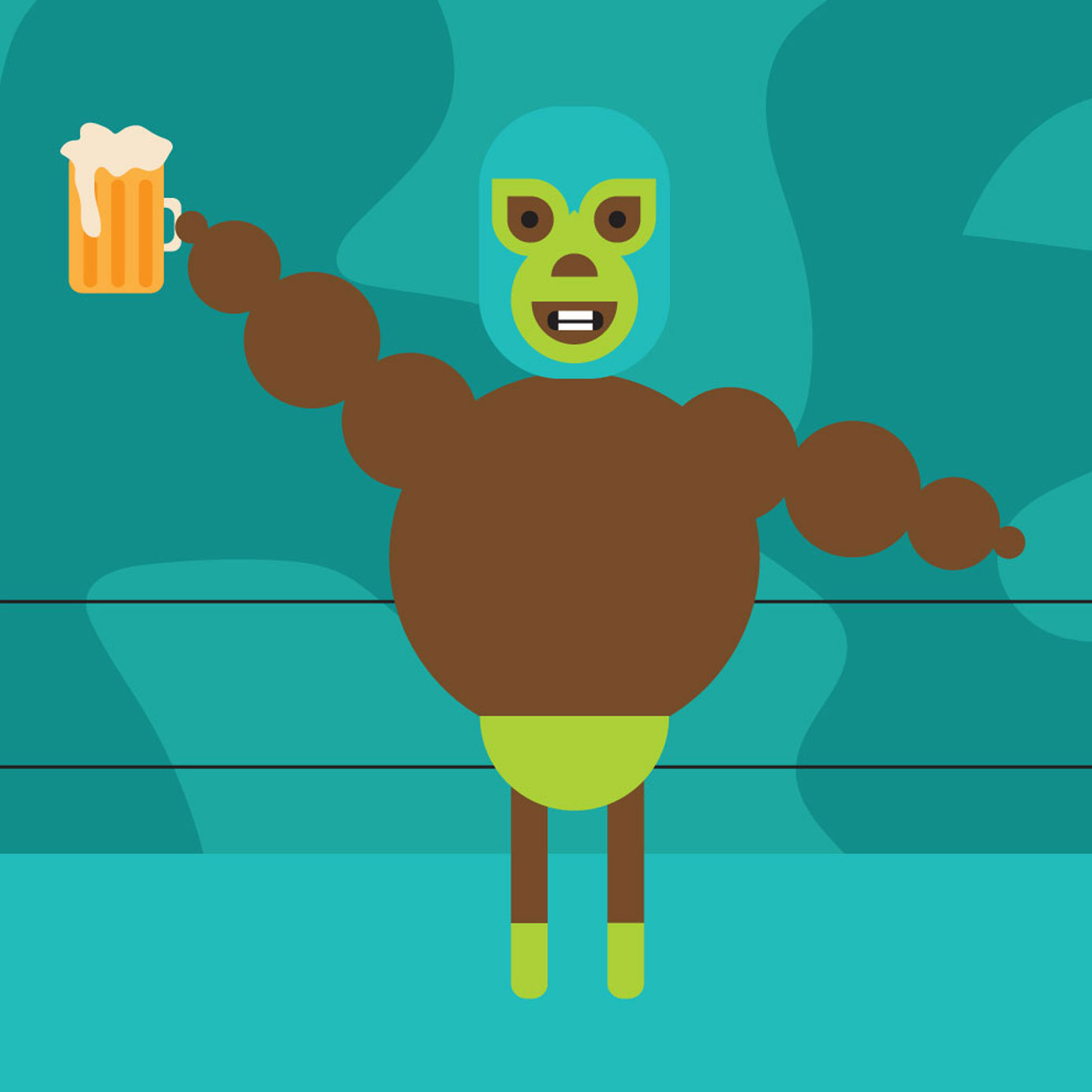In a dark basement of a cold-storage facility, the toughest, bare-fisted fighters battle for glory — and the fate of the world. These pugilists are pawns in a deadly game overseen by a cloudy-eyed and bloodthirsty Spaniard, and the stakes are larger than they could ever imagine. And it’s all sponsored by Modelo.
Lucha Underground, the El Rey network’s outlandish pro-wrestling television series, takes place in a quasi-Lovecraftian fantasy world in which actual legends of the industry battle fantasy characters invented for the show. Now in its fourth season, Lucha Underground (LU) recently underwent a significant overhaul after taking an almost year-long break from TV. The show dropped some of its cinematic camerawork in favor of grittier (and perhaps cheaper) production values, and changed the location of its ring, called “The Temple,” from a fictional Boyle Heights, Los Angeles arena to a secret Ice House in Downtown L.A.
Last but not least, Modelo, a label owned by the world’s largest beer company, Anheuser-Busch InBev, has come on as an extremely visible sponsor. The ring’s ropes are now Modelo’s colors, fights take place atop conspicuously branded floor mats, and announcers occasionally shout out the brand.
LU fans, called The Believers, are sharply divided on Modelo’s involvement. Some Believers are simply happy Lucha Underground found a way to continue to air, despite expiring contracts and low ratings. Others argue the obvious product placement distracts them from full immersion into the fantasy of LU.
Of course, macro beer companies sponsoring sports is nothing new. But LU is unlike other professional athletic leagues. Professional wrestling is a hybrid sport and meticulously staged theatrical event, requiring suspension of disbelief from participants and spectators — hence the term “Believers.”
This puts the medium in a strange place when it comes to sponsorships. Can an inherently fantastical entertainment product like LU partner with Big Beer to stay afloat, or does the intrusion of corporate interests distract from the illusion of the fights? When it comes to The Believers, is Modelo a curse or savior?
*
“I think it’s great that LU got a partnership that hopefully means more money for them, but I don’t like the Modelo signage in ‘The Temple,’” Marty DeRosa, co-host of the popular wrestling podcast Marty & Sarah Love Wrestling, says. “It doesn’t fit the aesthetic of an underground fight club.”
Professional wrestling relies on a narratological concept known within the industry as kayfabe. Essentially, kayfabe means suspension of disbelief. Anyone watching pro wrestling has to pretend they believe the staged rivalries and larger-than-life characters are real. Wrestlers, for their part, have to fully commit to their personas.
Modelo signage and occasional announcer shout-outs to the brand are obvious distractions from the kayfabe required of every pro wrestling match.
Fans suspect that kayfabe is one of the reasons the world’s largest pro-wrestling federation, World Wrestling Entertainment (WWE), has refused highly visible partnerships in the style of LU’s relationship with Modelo. WWE might want to keep sponsorship out of the ring to maintain its self-contained illusion.
Of course, WWE is also a for-profit business. It’s entirely possible that CEO Vince McMahon (who, confusingly, plays a villainous version of himself on WWE shows) has refused to partner with other companies because he is unwilling to share the mass profits WWE garners with any other corporate entity.
DeRosa, for his part, says he could accept subtler corporate marketing efforts, “as long as it doesn’t beat me over the head and constantly remind me who’s sponsoring the show.”
Mark Adam Haggerty, a prolific ring announcer who works with a handful of indie federations, disagrees.
“I see a beer sponsorship as a step in the right direction toward not only legitimizing Lucha Underground, but legitimizing wrestling as a whole,” Haggerty says.

Modelo has set its sights on doing just that. In 2018, Modelo also became a sponsor of UFC, the world’s largest mixed martial arts organization. The company is clearly in the business of courting a specific demographic of 21-to-24-year-old males.
Meanwhile, independent leagues like Party World Rasslin’ (PWR) in Austin, Texas, have made beer partnerships a core part of their businesses. With its ring located in the back of the 4th Tap Brewing Co-op, the league now sees this partnership as inherent to its success.
“4th Tap’s two founders were friends with some of our wrestlers and came to an early show,” Chris Monica, a promoter and performer with PWR, says. “ I guess they liked it, and thought it would be a good fit for the mission of the new brewery they were going to open: to support local art. 4th Tap is pretty much family, and we see them as an inextricable part of PWR.”
4th Tap has also teamed up with local bartenders to create themed drinks for PWR events, even working the products into the eccentric and comically complex mythos of the promotion.
“Originally, the PWR storyline featured a corporate sponsor called HELLSPORT who made a deadly, alcoholic energy drink,” Monica says. “At our early shows, 4th Tap sold a version of their +2 Vitality Session Ale as ‘Hellsport Lite.’ Later, when Hellsport revealed themselves as bad, that same beer was served as ‘DOOMLAGER’ at shows.”
Whereas Modelo’s LU sponsorship might strike some as cold, corporate, and kayfabe-non-adjacent, 4th Tap’s relationship with PWR feels both imaginative and grounded in reality. The small brewery has deep personal connections to PWR participants and fans, and it goes out of its way to support the league.
“As a general thing, I think getting sponsorships can be pretty cool,” Rory Blank, an artist on staff at PWR, says. “With beer and wrestling in particular, I think it’s an extremely intuitive pairing. People like to have alcoholic drinks at live events, and putting the two together as a package is a big selling point for audiences.”
Other indie leagues, like Philadelphia’s Chikara, wouldn’t dream of partnering with an alcohol company: Chikara’s events are largely geared toward kids and families — with audience members even actively policing each other to keep swearing and other inappropriate behavior to a minimum at live shows. Since Chikara exists alongside the Wrestle Factory, one of the world’s most esteemed wrestling training schools, the talent and quality of the brand is undeniable. But with animal-themed luchadors and comic-book- inspired lore, it might seem inappropriate to pursue beer partnerships.
“Chikara is family-friendly and is something that nobody should feel worried about bringing a young child or even your elderly neighbor to,” explains Thief Ant, a masked luchador with Chikara. “There are no expletives, no allusions to alcohol, narcotics, or sexual innuendos. This does hinder from accepting certain sponsorships.”
For companies with less specific niches, though, Ant sees these kinds of partnerships as perfectly reasonable. “You could even think of it as bringing realism to the product,” he says. “All boxing and mixed martial arts events have sponsors. Anyone that watches those products would most likely not see any difference when it comes to watching wrestling with sponsors on the mat, skirts, pads, and banners.”
*
Corporate dollars pay for all sorts of creative output these days, from vertical integration in sitcoms to the annual Capital One Orange Bowl. But in order to be successful, especially in a medium with fans as passionate as those of pro wrestling, the pairing has to feel authentic.
If that sounds fuzzy or unscientific, that’s because it is. Marketing is less of an exact science than those paying for it might hope.
“When I was a teenage punk, I probably would have considered taking money for just about anything as ‘selling out,'” Blank says. “But the truth of it is, there’s a lot of costs involved if you want to be able to spend time making things, and even more if you want to make things that people are going to actually look at.” If a 200-pound pro wrestler gets body-slammed onto an unbranded mat during an un-televised fight, do they even make a sound?
